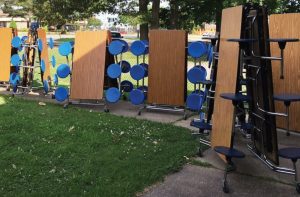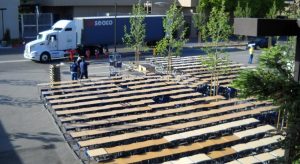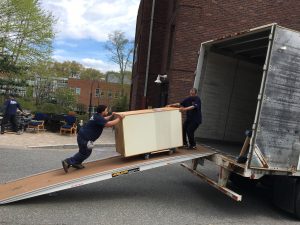Education Market Association essentials, Summer 2017
Copyright (c) 2017 by the Education Market Association, used with permission
Every school has excess furniture. It may be hundreds or thousands of pieces when you build a new school and empty the old one. It may be the odd stream of items that find their way to basement storage areas. It may be old cafeteria tables that you’re replacing, or old bleachers from the gym. Every day, every month, every year, schools have excess furniture.

What to do with it? That’s a painful question. You can put it up for auction or look for a reseller, but there’s not much demand. You can give it away to teachers, or have a yard sale for the community. But there’s not much demand. There’s just not much demand for used school furniture. So most of the time, it gets thrown away.
There’s an alternative: charitable reuse.
The Beginning of IRN’s Charitable Reuse: Boston, June 2002
A parking lot filled with furniture. That was the beginning of IRN’s Reuse Program.
IRN was established as a recycling cooperative for education and healthcare. IRN’s role was to take over members’ loading docks and find a home for all their recyclables: paper and cardboard, cans and bottles, scrap metal, plastics, computers, fluorescent lamps . . . . .
And then furniture. Boston College called, with all that dorm furniture in the parking lot. IRN looked at it and said, ‘This is good stuff. Why aren’t you giving it to a halfway house or a homeless shelter, someone who can use it?’ To which BC replied, ‘We’re in Boston. Inside ten miles there are three dozen schools and 40,000 dorm rooms. We all have this stuff to get rid of. We’ve filled up every shelter and thrift store in three states. We just need the furniture to go away.’ So IRN recycled it.
But IRN knew there had to be a better solution, and started making calls. Not to local charities, but to national and international organizations that provide relief and development aid on a large scale. Perhaps they would be able to use good quality furniture in the quantities that were available from IRN – hundreds, sometimes thousands of pieces at a time.
There Was Supply and Demand, But No One to Make a Match
What IRN discovered was a market failure. There was in fact a huge need among relief organizations for usable furniture – to rebuild after floods and earthquakes, provide families a better home, give students the chance to study at a real desk. There was more need for furniture than IRN could ever hope to supply. But there was no one making the match.
Among the generators – that is, the schools who had surplus furniture to dispose of –no one had the time and resources to network with dozens of charities who might be able to use the furniture. Among the potential recipients no one had the time and resources to contact the thousands of schools that might have usable furniture to offer. Neither side had the capability to plan and manage the projects to make the transfer happen – set up moving crews, organize transportation, pack trucks, fill out customs paperwork, track the furniture to its destination.
Meanwhile good furniture kept going into dumpsters, while kids kept doing their schoolwork on wood planks.
So IRN kept making calls. They started making matches with the larger charities, and began moving furniture. In 2002 IRN shipped two trailers of furniture. In 2003 they shipped 20. Then 85 in 2004. Then 259 in 2005, and from there the program has kept growing. Through mid-2017 IRN has shipped more than 5,500 trailers filled with furniture, provided by 535 organizations in 28 states, and supplying more than 125 nonprofit schools and charities in XXX states and XXX countries around the world. That’s charitable reuse.
K-12 is a pillar of IRN’s Reuse Program
The charities IRN works with are desperate to acquire classroom furniture and everything that goes with it – libraries, cafeterias, science rooms, teachers’ desks, bookshelves, work tables. They know that education is the best route out of poverty, but it’s hard to get much education sitting on a dirt floor. Since 2004, IRN has worked with 98 schools and districts from Maine to Southern California and from Florida to Washington. IRN’s biggest K-12 project recovered more than a half-million pounds from a district near Denver; the smallest captured a few desks and file cabinets – 640 pounds total – from a small school in the Boston suburbs. “K‑12 is the gold standard of all the furniture IRN handles,” says COO Dana Draper; “We can’t get enough of it.”

How Reuse Works
Simplicity and low cost are the keys to IRN’s Reuse Program. IRN knows that nearly every school is overwhelmed, understaffed, and working within a tight budget. They know that reuse has to be just as simple as throwing old furniture away, and cost less. Reuse has to be the easy choice. IRN makes it a simple, three-step process.
The first step is to get an inventory of the furniture to be disposed of. This is what IRN uses to make a match with the most appropriate charities. Says COO Draper, “Shipping costs are a big variable. Charities working in Asia want shipments from the West Coast; in Africa and the Mideast they want freight from the East; in the Caribbean and South America they want shipments from the East or Gulf States. Shipments from the middle of the country can go east or west, or south into Mexico. And we work with charities that support schools in American cities and Appalachia. They want shipments to originate as close as possible to their recipients.”
Labor is the next resource required. Sometimes IRN hires movers, but they prefer if the school or district contracts directly. Most have movers they already rely on, who know their schools and how they operate. IRN doesn’t like to get in the middle of those relationships. Equally important, if the school contracts directly IRN doesn’t take a markup, and that helps keep costs low.

With recipients and a labor force in place, the project is ready to go. IRN coordinates with the charity to set up transportation, with the mover to get the crew onsite, and with the school or district to make sure the doors are open, lights are turned on, and parking space is reserved for tractor trailers. A small project may involve a crew of three or four men loading a single trailer between breakfast and lunch. A large project may span a week or more, with multiple crews loading trailers simultaneously from different doorways, or crews moving between a dozen different schools loading 20 or 30 trailers over the course of several weeks.
“No two projects are the same,” says Draper. “Large and small. With elevators and without. In 90 degrees and roasting, or minus-10 and freezing. But the goal is always the same: keep it efficient, keep it cost-effective, finish on time, finish within budget.”
The Bottom Line: Schools Saving Money; People Helping People

IRN did its first K-12 project in 2004: two trailers, 18,000 pounds total, from schools in New Hampshire and Connecticut. In 2017, dozens of projects and millions of pounds later, IRN has another 40 K-12 projects on their schedule, and expects to fill another 300-350 trailers with desks, activity tables, bookshelves, and other furniture for children around the world.
“OUR COMMUNITY AND TAXPAYERS WIN, WE SEND THE RIGHT MESSAGE TO OUR STUDENTS, THE ENVIRONMENT WINS, AND CHILDREN FAR AWAY GET THE BIGGEST BENEFIT OF ALL.” DONNA WOODCOCK, PRINCIPAL, GREENFIELD (MASS.) HIGH SCHOOL
“IRN gave us a four-win solution,” says Donna Woodcock, principal of the Greenfield, Massachusetts, High School, where IRN removed more than 1,100 pieces for charitable reuse. “Our community and taxpayers win, we send the right message to our students, the environment wins, and children far away get the biggest benefit of all. It’s not often that a single project can do so much good.”
Please let us know if you’d like more information, or have surplus furniture that deserves to be reused.

